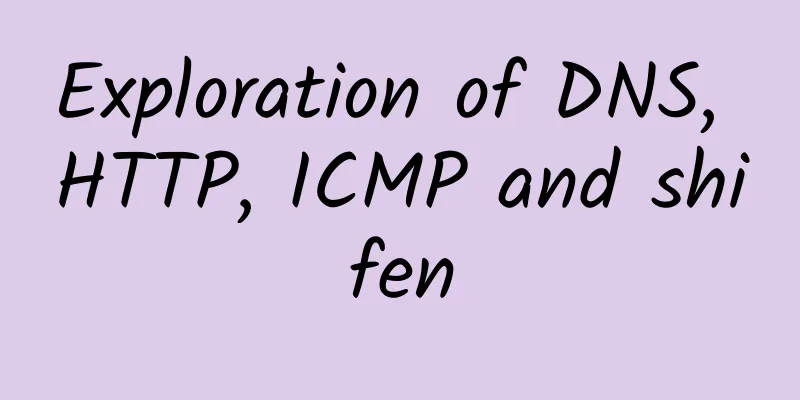Exploration of DNS, HTTP, ICMP and shifen

|
Hello friends, in this section I will share the ICMP protocol and the protocols involved when curl accesses http websites. ARP protocol supplementLet me first add some information about the ARP protocol mentioned above. picture The MAC address is 6 bytes, the first three are the manufacturer, and the last three are the serial number. ICMP ProtocolInternet Control Message Protocol. Triggered when pinging. Here, ping 192.168.2.187 (host address) directly on the virtual machine picture It can be seen that when a ping request is made, the type of the message is 8, which means Echo (ping) request. picture When replying, this type is 0, indicating (Echo (ping) reply). picture DNS protocolDomain Name System, Domain Name System. When visiting Baidu, the first step is the domain name resolution. picture The captured packages are as follows 👇 picture picture The picture corresponds to request 21, and we can see that DNS is based on UDP (User Datagram Protocol). There is also a type called A, which is for requesting an ipv4 address. 22 is type: AAAA, which is the IPv6 address. When I built a blog before, there was a domain name resolution link, and I also had to configure the resolution of this A (I realized it later~) Let’s take a look at the response data 👇 CNAME is a CNAME record Learn something new: Baidu's alias is www.a.shifen.com Here we also successfully obtained the ipv4 address picture Eat melonOh wow, I accidentally discovered another meaning of the name of a big company👇 We are all shifen 👍 picture picture HTTP Protocolpicture After the DNS resolution is successful, the IP address is obtained. The IPv4 address used here is used to establish a TCP connection. After the three-way handshake, the HTTP request is sent. The Get request is as follows. The User-Agent is curl (usually seen are browser logos) picture The TCP segment size is 77, and [Next Sequence Number: 78 (relative sequence number)] picture Response 👇 Starting from line 30, ACK = 78 is just right. Mainly look at the two items 31 and 33, PSH + ACK: used to transmit data and requires the receiving end to immediately hand it over to the application layer for processing. The data length here exceeds the MTU (Maximum Transmission Unit) of 1500 bytes and needs to be fragmented. Therefore, the appearance of [TCP segment of a reassembled PDU] in 31 means that it is not complete, but only a part of the PDU (Protocol Data Unit). You can see the record of this reassembled TCP in 33 👇 [2 Reassembled TCP Segments (2781 bytes): #31(1440), #33(1341)] picture Next is the HTTP content, which is similar to what you see on the browser, that is, the response line, header, and body. I won't go into details. picture The following is the content of TCP's four waves. picture After curl is finished, check this immediately Semi-connected queue , and found that it is still waiting to be closed. picture After waiting for 2MSL (2MSL = 60s on Linux), it is closed. picture Finally, let’s supplement this model and see which layer the previously introduced protocols are at 👇 OSI seven-layer model TCP/IP Layer 4Compared with the OSI seven-layer model, the TCP/IP four-layer model merges the presentation layer and session layer into the application layer, and merges the data link layer and physical layer into the link layer. |
<<: Can the interviewer ping 127.0.0.1 after being disconnected from the Internet?
Recommend
Avaya's 20th anniversary marks its start again. Fu Lili, president of Greater China, says Avaya will transform to a cloud model
[51CTO.com original article] On October 1, 2000, ...
What security risks may cause the Internet speed to suddenly slow down?
[[434023]] This article is reprinted from the WeC...
"Broadband China" has not yet succeeded. FTTH should move from "bombardment" to "intensive cultivation".
FTTH has been around for 14 years since its promo...
Six tips for optimizing network security vendor integration
As the network security situation becomes increas...
Riverbed Retail Digital Transformation Survey Results: The Next Three Years Will Be Critical for the Development of Physical Stores
The retail industry was born along with human civ...
Talking about HTTP connection related knowledge
[[374909]] This article will first introduce the ...
Where are the telecom operators headed in 2019?
Change leads to smooth flow, while no change lead...
QuickPacket: $49/month-E5-2683v4, 64G memory, 1TB or 500G SSD, 50TB/1Gbps, Los Angeles data center
Readers who followed the blog in the early days m...
818 Cloud Go: Tencent Cloud offers cloud servers starting from 74 yuan/year, 1C2G5M for three years starting from only 288 yuan
As June begins, all major online platforms have l...
RAKsmart: VPS flash sale from $0.99/month, cloud server flash sale from $1.99/month, Hong Kong/Japan/Korea/Germany/US data centers
RAKsmart is offering flash sales for VPS and clou...
Don't forget to bury the network cable when renovating. There are also ways to bury the network cable.
Every year in the "golden March and silver A...
F5's 2022 State of Application Strategy Report shows that edge deployment and load security have become the focus in the Asia-Pacific region
Digital transformation is in full swing, and tech...
Why is the price of GPRS module as low as ten yuan? My experience in the localization process of IoT module
The development history of the entire communicati...
RAKsmart flash sale server starts from $30/month, cluster server starts from $142/month, in the US/Japan/Korea/Hong Kong data centers
Earlier this month, I shared information about RA...
Hosteons adds Las Vegas data center, KVM architecture, free defense, 20% off monthly payment
Last month, Hostons added a Jacksonville data cen...









